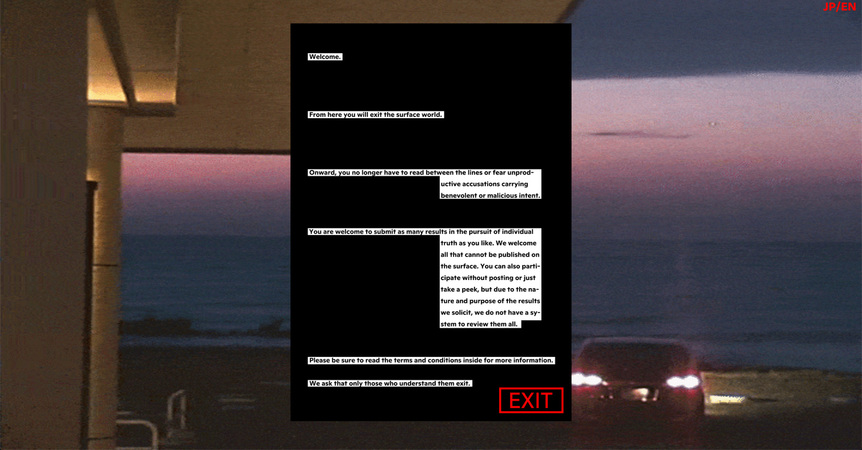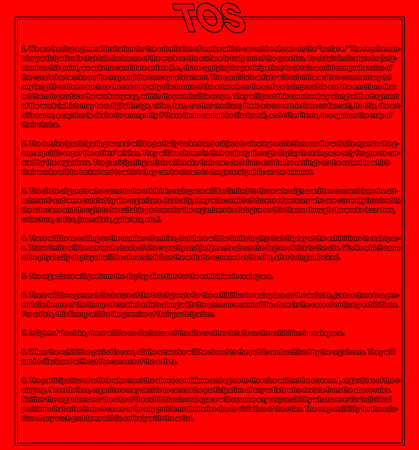
R
E
V N
E
X
T
Detailed screenshot of the Dark Independent website.
Amid lockdowns and social-distancing rules prompted by Covid-19, museums and galleries across the world rushed to present their exhibitions, educational programs, and collections online. The release of art into the informational flows of the internet fed the assumption that the global network increases accessibility to knowledge. Against this backdrop, the exhibition and online project Dark Independent (DI) stood out because of its deliberate inaccessibility. Organized by Ryuta Ushiro (from the art collective Chim↑Pom), the duo Kyun-Chome, Osamu Matsuda, and Tomohito Wakui, the show was held for six days in late May at an undisclosed location in Japan. Invitations were only extended to an audience of up to 94 individuals, comprised of big-name Japanese curators, critics, collectors, and other insiders who were handpicked by the organizers. For those on the list, DI was a “safe space” to encounter ideas that were not politically correct, possibly to the extent of illegality. The project’s cryptic online interface remains available to anyone who creates an account, but only contains hints of the displayed artworks for uninvited guests.
Although selective in terms of its visitors, DI sourced its artworks via a virtual open call. Specifically, organizers solicited art that could not be disclosed on “the surface.” The word “surface” references “the surface web”: the mainstream plane of the internet indexed by search engines. Despite its seemingly vast and never-ending interface, the surface web contains only ten percent of the information on the internet, with private information and encrypted, more nefarious content dwelling below. DI draws comparison between the surface web and the art industry’s recent masquerade of democratization. Despite galleries, museums, and even artists’ own quickness to circulate art online, what is disseminated often undergoes double-conformity: content must be deemed inoffensive for the intended audience and adaptable to the internet platform that presents it. DI thus seeks what goes unsaid given such conditions.
DI’s website leaves clues for the sort of art that lies beyond the scope of what the industry sanctions. The webpage’s rudimentary design recalls an abandoned webpage from the early 2000s, with its blocky fonts, awkward text highlights, garish colors, and mysterious, flickering pixelated backgrounds. This cyberpunk aesthetic situates the online visitor within the mindset of a hacker. To enter, audiences must click a fluorescent red “Exit” button, signaling their departure from “the surface world.” They are then confronted by a list of nine rules ensuring that the artworks never reach the surface. These elements evoke image and message boards, such as subreddits or 2chan, which often declare their own regulations for the discussion of sensitive topics, most commonly pornography, gore, and textual hot takes that spew racism and bigotry. For those who have braved the journey, DI most precisely recalls the dark web, an encrypted part of the internet that allows illicit subjects to freely circulate, like malicious software, child pornography, drugs, and weapons.
These internet spaces are also intellectual gathering places for neoreactionaries: blogger-academics who declare democracy, liberalism, and even human rights as lost causes. British philosopher Nick Land’s online manifesto “The Dark Enlightenment,” which was translated into Japanese last year, clearly influenced the title and impetus of DI. Land and other neoreactionaries espouse accelerationism, the idea that global capitalism must be sped up to further merge humans and technology, and to free us from the stifling mind control of liberalism and political correctness. Within accelerationism, the line between liberation and destruction is unclear.
While neoreactionaries are forthcoming in their extreme stances, most viewers of DI are left guessing as to what its content offends or provokes. Once visitors agree to DI’s terms, create an account, and log in, a map of an unspecified locale fills the webpage. Orange location pins and floating square images display the names of participating artists, as well as glimpses of their work. Unlike an ordinary digital map, the user cannot click on its features. As the artworks tauntingly lie just beyond reach, viewers must imagine for themselves what they believe to be disturbing enough to be guarded in this way. They are “in the dark” as to what the “dark” entails. In turn, the exhibition becomes a reflective surface that casts whatever the visitor projects as offensive or taboo back onto themselves. The map is also populated by the DI logo: a cell-like form with smooth edges but a central, jagged hole, like a gaping mouth. Scattered across the screen, the emblem evokes the facades of the artworks, which conceal deeper layers, and the shadowed depths held within viewers’ minds. This darkness holds truths that our socialized selves deny.
A green text bar, labeled “Google,” a marker of the surface web, runs across the bottom of the webpage like a news ticker. It delivers a looping stream of cryptic axioms, including a quote from the Chinese philosopher Jianzhi Sengcan and a manifesto from the organizers themselves. Together, they condemn binaries of good and evil, light and dark. They also denounce art’s increasing alignment with justice, revealing the influence of neoreactionary thought. The organizers cite the 2019 Aichi Triennale as an example: two artworks that touched on historical sore points led to the temporary closure of one of the festival’s sections. In critiquing the quickness to sort art as right or wrong, DI reveals its contempt for the pressure on artists to be politically correct and for virtue signaling in art discourse. But in adopting the positioning and lingo of the internet edgelord to make this point, the project lends itself to contradiction. DI does not acknowledge that the attitudes of the internet crusaders that they emulate—those who pride themselves on controversial hot takes—rely on a polarized atmosphere to maintain the shock factor of their views. If DI hopes to rouse people to recognize nuance, or to live in the shadow between black and white, then how do they reconcile the fact that their neoreactionary ideologies are so vulnerable to hatred and extremism? The question remains: if we are to make space for the consumption of darkness and isolation, how do we prevent the darkness from consuming us?
Kaitlin Hao is an editorial intern at ArtAsiaPacific.
To read more of ArtAsiaPacific’s articles, visit our Digital Library.

















